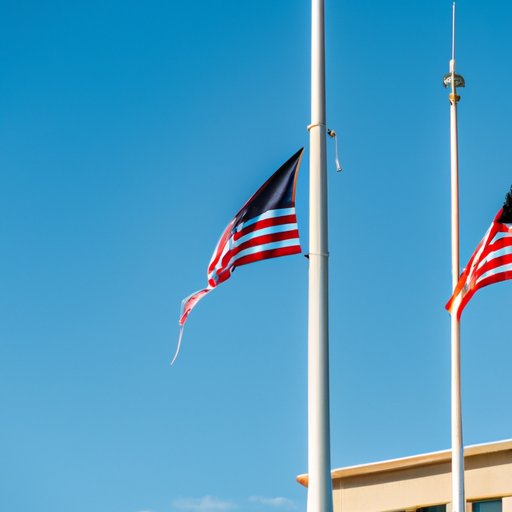Why Are Flags Half-Mast? Understanding This Age-Old Tradition
At some point in our lives, we’ve all seen flags half-masted. But why do we see this custom so frequently? What does it signify, and why is it important to understand it? In this article, we’ll explore the practice of half-masting flags from a historical, cultural, and political perspective to gain a better understanding of its significance.
Historical Perspective
The tradition of lowering flags to half-mast has its roots in naval tradition, where ships would lower their flags to indicate mourning or respect for a deceased person. This practice was initially done by covering the ship’s masthead with black fabric to signify the ship’s mourning. This custom has since been adapted to land use, where flags are lowered to half-mast on flagpoles.
The first recorded instance of the half-masting of flags in the United States occurred in 1799 when George Washington passed away. All navy yards and vessels were ordered to fly their flags at half-mast to mourn the loss of the country’s founding father.
The modern practice of half-masting flags saw significant changes in the 20th century with the introduction of protocol in the manner that the flag is raised to full mast, lowered to half mast, and then raised again to full mast.
Current Events
Flags are often half-masted on the occasion of a tragedy, national mourning, or the passing of a prominent figure. Recent instances where flags have been half-masted include the passing of Ruth Bader Ginsburg, the former Associate Justice of the Supreme Court of the United States, in 2020; the mass shooting that occurred in El Paso, Texas, in August 2019, and the terrorist attack on the Manchester Arena in May 2017.
Flags are also half-masted to commemorate national holidays such as Memorial Day and Patriot Day, which honor those who lost their lives in service to their country.
Political Significance
The practice of half-masting flags carries a significant political and social significance. Half-masting the flag is a symbol of respect and mourning, with the degree of the flag’s lowering indicating the degree of the honored person’s eminence.
Half-masting the flag is also used as a symbol of protest or solidarity. In some parts of the world, political or social movements may half-mast the flag to protest events or authorities.
Cultural Relevance
The meaning of half-masting flags varies widely among cultures. In the United States, for example, the flag is half-masted as a sign of mourning. In Japan, the custom of half-masting the flag is called “miburo,” and it is done to signify an emperor’s death.
In many cultures and religions, the color of the flag that is half-masted is significant. Black reflects mourning, red signifies revolution and struggle, and white signifies peace.
Symbolism
The symbol of the half-masted flag signifies that a nation, community, or organization is mourning the loss of life. The lowered flag embodies a somber spirit of dignity, respect, and solemnity.
The practice of half-masting flags often denotes a sense of collective loss while also honoring the deceased. This symbol represents a country, community, or organization, showing empathy and respect for the departed.
Personal Reflections
Half-masting flags can evoke profound emotions and feelings from individuals who are impacted by it. For those who have lost loved ones in service to their country, half-masting flags can provide a sense of comfort and a reminder that their loved one’s sacrifice has not been forgotten.
In the context of national tragedies, half-masting flags can provide an outlet for communities to express their sorrow and unite together during challenging times.
Etiquette and Protocol
Flag protocol calls for flags to be lowered to half-mast when a tragedy occurs, followed by being raised to full-mast at noon before being lowered again at sunset.
When half-masting flags, it is important to ensure that the flag is flown at a position where the center of the flag is one-half mast’s distance from the top of the pole.
Conclusion
The practice of half-masting flags is an age-old tradition that carries significant historical, cultural, and political significance. It is a symbol of collective mourning and respect for the departed. Understanding the meaning behind this custom is essential in appreciating its significance.
As witnessed in recent events, it serves as a reminder of the importance of empathy and community in times of tragedy. May all future occasions of the half-masting of flags be met with compassion, understanding, and a sense of renewed purpose.
